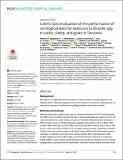| dc.description.abstract | Brucellosis is a neglected zoonosis endemic in many countries, including regions of sub-Saharan Africa. Evaluated diagnostic tools for the detection of exposure to Brucella spp. are important for disease surveillance and guiding prevention and control activities.
Methods and findings
Bayesian latent class analysis was used to evaluate performance of the Rose Bengal plate test (RBT) and a competitive ELISA (cELISA) in detecting Brucella spp. exposure at the individual animal-level for cattle, sheep, and goats in Tanzania. Median posterior estimates of RBT sensitivity were: 0.779 (95% Bayesian credibility interval (BCI): 0.570–0.894), 0.893 (0.636–0.989), and 0.807 (0.575–0.966), and for cELISA were: 0.623 (0.443–0.790), 0.409 (0.241–0.644), and 0.561 (0.376–0.713), for cattle, sheep, and goats, respectively. Sensitivity BCIs were wide, with the widest for cELISA in sheep. RBT and cELISA median posterior estimates of specificity were high across species models: RBT ranged between 0.989 (0.980–0.998) and 0.995 (0.985–0.999), and cELISA between 0.984 (0.974–0.995) and 0.996 (0.988–1). Each species model generated seroprevalence estimates for two livestock subpopulations, pastoralist and non-pastoralist. Pastoralist seroprevalence estimates were: 0.063 (0.045–0.090), 0.033 (0.018–0.049), and 0.051 (0.034–0.076), for cattle, sheep, and goats, respectively. Non-pastoralist seroprevalence estimates were below 0.01 for all species models. Series and parallel diagnostic approaches were evaluated. Parallel outperformed a series approach. Median posterior estimates for parallel testing were ≥0.920 (0.760–0.986) for sensitivity and ≥0.973 (0.955–0.992) for specificity, for all species models.
Conclusions
Our findings indicate that Brucella spp. surveillance in Tanzania using RBT and cELISA in parallel at the animal-level would give high test performance. There is a need to evaluate strategies for implementing parallel testing at the herd- and flock-level. Our findings can assist in generating robust Brucella spp. exposure estimates for livestock in Tanzania and wider sub-Saharan Africa. The adoption of locally evaluated robust diagnostic tests in setting-specific surveillance is an important step towards brucellosis prevention and control. | en_US |

